Twitter has a bot problem; that much is undeniable. A study performed last year indicates that there may be as many as 48 million bots on Twitter! Now, of course, some of those are fine. They’re utility bots or gimmick bots or humor bots, accounts that have some value, even if they’re not human. On the other hand, the majority of those are going to be fake accounts run by spammers in an attempt to sell followers, retweets, or propaganda.
If you had a good, definitive way to get rid of bots from your circle of influence, would you use it? If you could make sure new followers were not bots, you could guarantee a genuine audience.
This is what TrueTwit attempts to promise, and it’s where they fall short. So what is TrueTwit, can using it hurt your marketing or your profile, and what can you do instead?
What Is TrueTwit?
Let’s start with the basics; what is TrueTwit, what do they claim to do, what do they actually do, and what does the whole thing cost?
First of all, TrueTwit is a “validation” service for Twitter that has been around for several years. Their website looks pretty janky and has some odd decisions (why is their homepage a .form?) but they say never to judge a book by its cover, so let’s dig in.
When I say validation, I don’t mean verification, so get that out of your head. TrueTwit has nothing at all to do with Twitter verification, even if that system wasn’t shut down due to issues with fake news, exploitation, and hate speech.
No, by validation, I mean in the same way that you send out a validation email to new subscribers to your email mailing list. You want a double opt-in system so you can make sure your new subscribers are real, and not bots or mailing lists themselves.
The idea is the same; when someone follows you on Twitter, TrueTwit attempts to validate whether or not they’re a real person or a bot. Using their system, the goal is to make sure your entire audience is made up of humans, not bots; you can use TrueTwit to filter out the bots.
It sounds great! An audience made up of pure humans, no bots, is a great audience to reach with your marketing. You’re bound to have higher reach, higher conversion rates, and more active conversations – not to mention a better engagement to follower ratio – with that kind of pure audience.
TrueTwit makes these promises, but do they do what they say? Well, both yes and no. Here’s how the whole thing works.
TrueTwit has two account levels; basic and premium. They operate differently, so it’s not just a “more features + analytics” upgrade.
TrueTwit Basic uses what is essentially email verification, except not via email. You sign up for TrueTwit. When someone new follows you, TrueTwit checks to see if you follow them already. If you do, no action is taken. If you do not, TrueTwit checks to see if that person is a member of TrueTwit. If they are, no action is taken. If they are not, TrueTwit sends them a direct message on Twitter. This message informs the new follower that you are a user of TrueTwit validation, and asks the user to complete some steps to validate that they are in fact a real person. It also includes a CTA to try to get the user to sign up for TrueTwit to avoid having to encounter this DM in the future.
The validation, by the way, is basically just a captcha. If you’re familiar with any of the many black hat techniques used in marketing, you know pretty much every method of captcha is easily broken, so who knows how valid this whole thing is.
If the user completes the captcha and validates, or is a TrueTwit member, you are sent an email confirming that this new follower is a real person. If they do not complete it, you are notified that the new follower is likely a fake account, and can take action accordingly.
It should be noted that TrueTwit does not filter your followers. They do not follow or unfollow accounts, nor do they block or remove people from following you. It is entirely up to you to make the judgment as to whether or not to remove the new follower.
TrueTwit Premium removes the direct messaging aspect of the entire process, which is, well, the entire process. Instead, it replaces it with a sort of profile analysis. They would like you to believe it is a deep AI-driven analysis that examines tweet behavior and profile information to determine whether or not an account is a bot. In reality, it just checks for repetitive tweets or spam links, or empty profiles, and flags them as fake. All of this, which you can do at a glance yourself, for the low price of $20 per year. They also include a full follower analysis, so you can just browse through your followers and remove any it flags as spammers, if you decide to take action.
Again, even with Premium, TrueTwit does not take any action itself. It simply gives you information based on its judgment, which you can use to remove or block a fake account if you desire.
The Problems With TrueTwit
There are, frankly, quite a few problems with TrueTwit.
First of all, if you’re using the basic membership, you’re going to be sending a direct message to every new follower. Since the heyday of TrueTwit has passed, fewer and fewer people are actually using the service, so the “hey, you’re already a member, no need for a DM” function triggers less and less.
If you’ve read our past posts about welcome DMs, you know they’re generally a bad idea. Many users don’t want to be spammed by the people they follow, and something as blatantly automated – and accusatory – as TrueTwit is going to rub a lot of people the wrong way. Since many people have never heard of the service, they’re going to distrust it naturally, and many won’t want to perform any action that’s taking them to a third party site when all they wanted to do was follow someone on Twitter.
So already you have one major issue; sending out unwanted DMs is spammy and will drive a lot of new users away.
Now let’s think about the kinds of people who will or will not want to click through a captcha to validate their account.
- Spam accounts run by bots will never view a DM and will not be validated. This is good and is exactly what TrueTwit is counting on.
- Real accounts run by lazy people who don’t care about their DMs will not be validated. This is bad! They’re real people!
- Real accounts run by people who just don’t want to mess around with a service they’ve never heard of will not be validated. This is bad! They’re real people!
- Real accounts who are skeptical of services they’ve never heard of, or who don’t want to initiate a third party validation process, will not be validated. Again, bad! Real people!
- Real accounts that really want to follow you and will jump through hoops to do it will be validated. This is good, and is exactly what TrueTwit wants to happen.
- Fake accounts run by spammers with captcha-breaking software can easily validate themselves. This is bad! They’re validated bots!
- Fake accounts run by people with a desire to appear real – see all of the recent fake news controversies – will easily be able to validate. This is bad! Those accounts are insidious and can lead to a lot of fake news spreading around!
If you decide to pay the fee and upgrade to Premium rather than Basic, you have a different issue. Sure, you get rid of the DMs, and you don’t need to worry about user actions. On the other hand, you’re relying entirely on TrueTwit being able to analyze a Twitter account properly.
This means it will catch obvious spammers, which is fine. It also means it will catch users who primarily use Twitter to enter contests and follow brands they like, even if there are real people behind them. It also means it won’t catch the kinds of accounts that work hard to appear real, but are fake.
In both cases, it’s easy enough for a dedicated spammer to defeat TrueTwit validation with little or no effort. Meanwhile, validation is liable to flag plenty of valid accounts as fake, which can lead to you filtering out worthwhile followers.
On top of all of this, again, TrueTwit doesn’t take any actions themselves. They simply give you information that you’re supposed to use to make a judgment, and none of it – other than perhaps membership with the service – is unique to TrueTwit. It’s all information you can see just by looking at the account and making a judgment yourself.
If you don’t believe that TrueTwit is pretty valueless, just read their own FAQ:
- “TrueTwit doesn’t make any kind of judgment as to whether or not anyone is or is not or may be or may not be a spammer.”
- “TrueTwit does not know if you are a spammer (or not). TrueTwit just analyzes your posts to see if they have commercial content, adult content, or appear to be from an automated user.”
- “If a spammer is human, they will get through.”
Do those sound like good statements for a validation service to make? I certainly don’t think so.
Now take a look at the official TrueTwit Twitter account. Up for a laugh? Just look at that nonsense! Why did they try to tie themselves to a bunch of random pictures? Why are they posting the same thing over and over? It’s complete nonsense, and if that account followed me, I’d immediately flag it as spam. Hell, TrueTwit’s service would flag it as spam!
TrueTwit Versus Good Marketing Practices
So let’s sum things up. TrueTwit is obviously bad for your account, but let’s nail down exactly why.
First of all, the free service spams your followers with DMs. This is a terrible practice even if you’re just welcoming them into the fold and giving them some kind of valuable coupon, free product, or other offer. Something that just accuses a new user of being fake and demands validation is the last thing you want to do. It’s like if Target started carding people with valid IDs before they can shop.
Secondly, they admit that their service basically provides no more than the most baseline possible filtering functionality. They can notify you when an obvious bot follows you, but just clicking on the account can show you that with your own two eyes. You’re just looking at an email or the TrueTwit dashboard instead of Twitter, for whatever reason.
Third, they don’t take any action themselves! You still have to analyze the account, based on their recommendation or not, and make the choice to block them if you want to. All you’re doing is adding one semi-useless piece of data to your analysis.
So what should you be doing instead? Every time someone follows you, examine their account and determine if they’re a bot or not. It’s pretty obvious when a fake account follows you, and you can block/report them if you want. Or you can just… not do that.
After all, unlike Facebook or the other more heavily filtered social networks, there’s nothing lost by having a bad actor following you. Sure, your account might look a little worse if someone runs a fake follower scan on you, but no one on Twitter is without fakes. As long as you’re not buying thousands of fake followers and hoping no one notices, you should be fine with a few fakes, and purge the worst offenders when you see them.
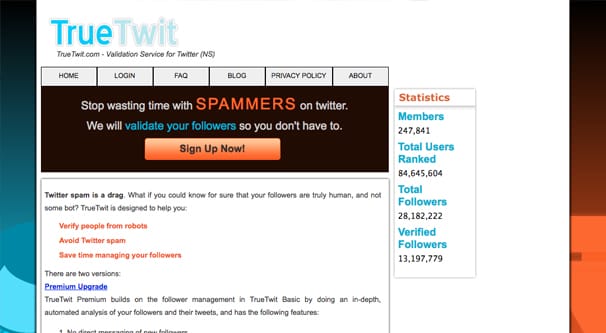
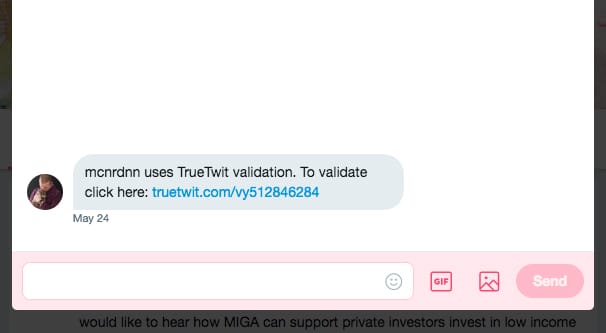
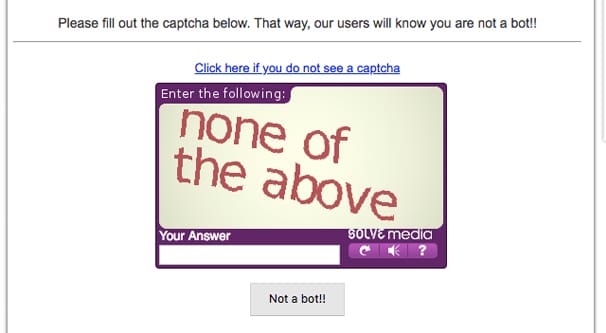

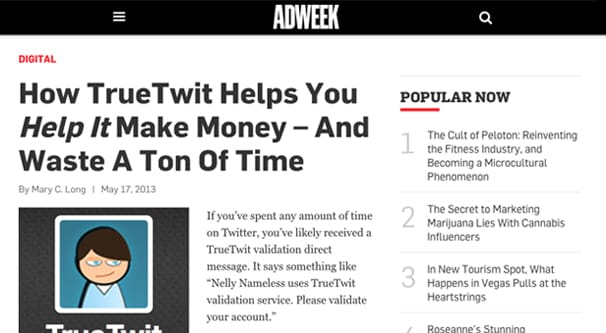
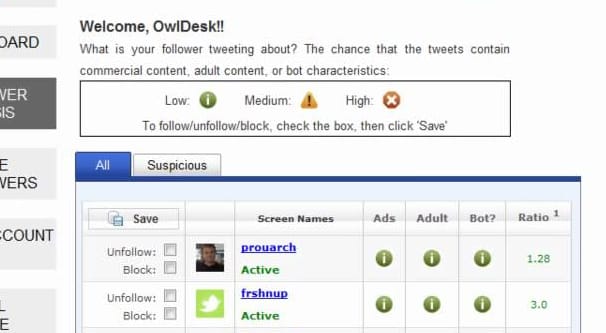
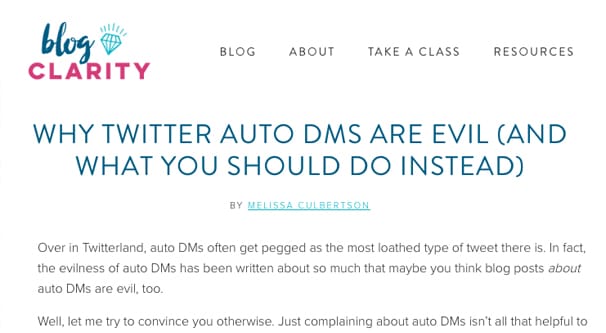




Every time I get a truetwit DM I go to the user’s page, unfollow them, and block them.
I had 3 users that sent my those annoying links to sign up to Truetwit and I did and I should know to block them but it was too late. Their Truetwit just uploaded a very bad ransomware virus into my phone that did permently damage to my phone that can’t be repaired. It overheated my phone so high that it shattered my touchscreen phone. They are going to have a nasty bad review on their website when I am done with them.
Hi Emery, holy cow, that’s the first I’ve heard of something like that happening. Are you sure you got the virus on TrueTwit?